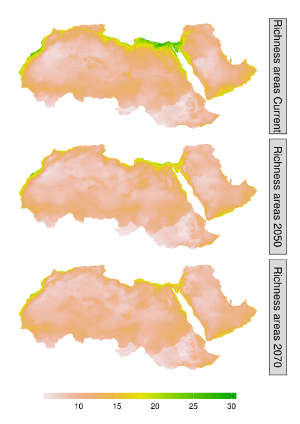From Architecture to AI-Powered Building Diagnostics: Tarek Rakha’s start-up story
10 June 2025
Published online 7 February 2019
Biodiversity in the Afro-Arabian region is highly vulnerable to climate change, according to recent research.

Alaaeldin Soultan
Enlarge image
According to the model, developed by researchers at Germany’s Max Planck Institute for Ornithology, mountainous species in the Afro-Arabian region will suffer less from climate change than desert and plain-dwelling animals. “But that’s only true if they are able to migrate and disperse freely to new favourable habitats,” says wildlife conservation expert at Max Planck, Alaaeldin Soultan, warning that physical barriers will make this dispersion less likely in the future.
The high geographic diversity of Morocco’s Mediterranean coast and the Sinai Peninsula make them the region’s top biodiversity hotspots, according to the model’s findings. They are crucial for species’ resilience and adaptation, and serve as stopovers for migrating birds.
The model provides conservation managers and practitioners with the information needed to implement effective conservation plans to protect the region’s biodiversity.
The researchers developed the model to assess the Afro-Arabian region’s biodiversity and its ability to respond to climate change. Data on biodiversity, species’ distribution, animal density and behaviour across the region is scarce. Similarly, little is known about the ability of endemic desert species to cope with diminishing food availability, changing rain patterns and other conditions caused by climate change.
Soultan and his colleagues developed a statistical model2 that assesses species’ distribution based on scarce but reliable records. Next, they applied an ecological modelling framework to obtain information on the contemporary conservation status of species, and to evaluate projected climate change impacts on the endemic species in the Afro-Arabian region, Sahara-Sahel and Arabian Desert.
For Soultan, long-term protection of thriving pockets of biodiversity will depend on funding to train conservationists and rangers. “Conservation without funding is just conversation,” Soultan says, pointing out that while the Sahara covers 43% of Africa’s land mass, it only gets 12% of the funds earmarked for Africa by the Global Environment Fund (GEF).
Sherif Baha el Din, one of Egypt’s leading conservationists, welcomes the focus of this study on the Saharan biodiversity, a region that does not get much traction in conservation circles.
Baha el Din, who was not involved in the study, says the relatively few highly adapted species in arid ecosystems play a very significant role in many areas of the world. “Their loss would be catastrophic, and their sensitivity to climate change and direct human activities is great,” he says.
doi:10.1038/nmiddleeast.2019.18
Stay connected: